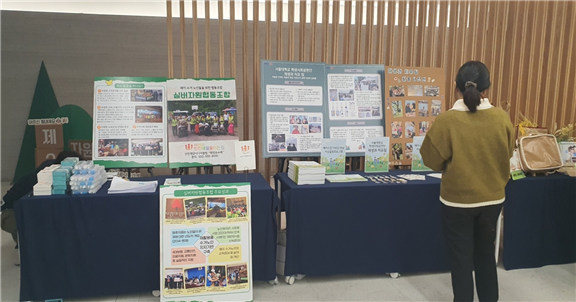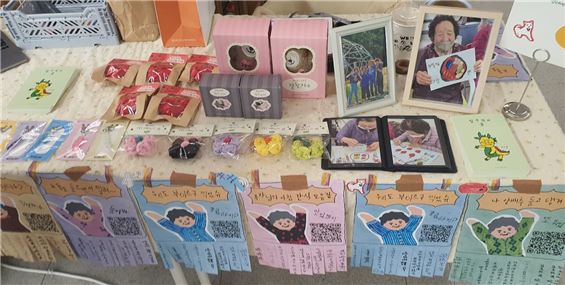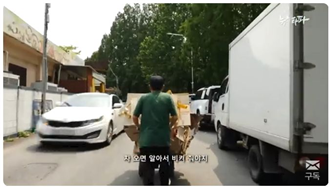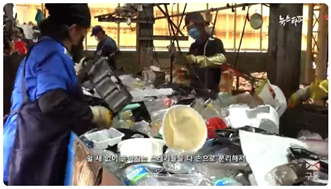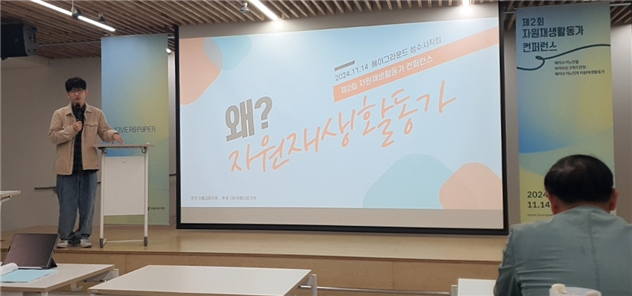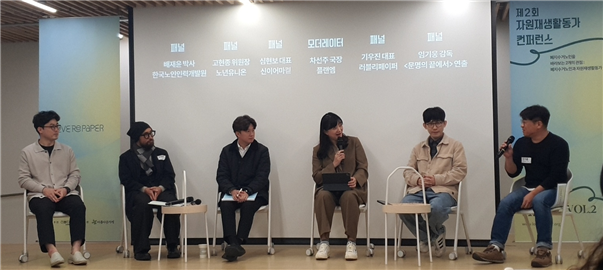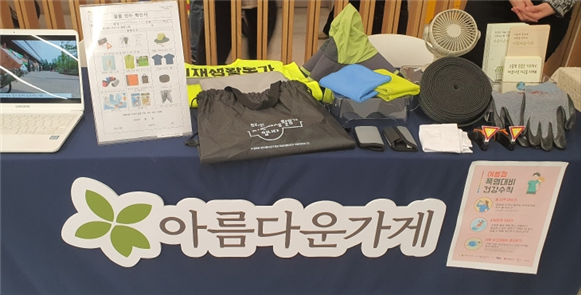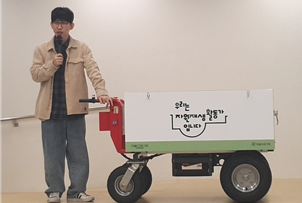[Case 27] Special Coverage – the 2nd Resource Recovery Practitioners’ Conference
Special Coverage
the 2nd Resource Recovery Practitioners’ Conference
In its 25th issue of Best Practices: Advancing Older Persons’ Rights, ASEM Global Ageing Center introduced LOVERE:PAPER, a non-profit social enterprise dedicated to supporting older waste collectors through various initiatives.
This edition provides a vivid account of our visit to the 2nd Resource Recovery Practitioners’ Conference, LOVERE:PAPER’s annual event held in November 2024, where discussions on the challenges faced by older waste collectors and viable solutions take place.
On November 14, 2024, the basement floor of Heyground, a co-working space in Seongsu-dong, buzzed with activity as people gathered for the second Resource Recovery Practitioners’ Conference. A total of 67 participants attended, including many who had also joined last year’s inaugural event. The venue was filled with energy even before the conference officially began, with small groups forming to exchange ideas and conversations. At the back of the hall, colorful booths showcased the work of organizations dedicated to supporting older waste pickers, fostering vibrant engagement among attendees.
[ Booths showcasing various initiatives supporting older waste pickers (above)
Products featuring artworks by seniors on display at the New Year Market booth—named as a clever blend of the English word "senior" and the Korean pronunciation of "new year." (below) ]
* * *
The conference opened with a screening of Anthropocene, a film directed by Lim Ki-woong, the Grand Prize winner of the 21st Seoul International Eco Film Festival. This 40-minute documentary follows the journey of urban waste, beginning with the observation that cities have always depended on certain groups of individuals to handle discarded materials. From the rag pickers of the past to today’s older cardboard collectors, these groups represent some of the most vulnerable members of society.
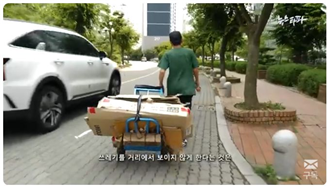
[ Screenshots from Anthropocene ] (Source: Newstapa’s YouTube Channel)
The film’s camera closely follows an elderly waste picker pulling a cart loaded with cardboard along the roadway. Despite the constant risk of traffic accidents, he perseveres to make ends meet. The junkyard where he trades not only handles waste paper but also processes discarded plastics and scrap metals, such as aluminum and iron. The waste collected by senior pickers passes through small-scale dealers, mid-scale intermediaries, and eventually major dealers before arriving at a massive recycling facility. There, the film captures mountains of waste gathered from across cities and elderly workers sorting through cascades of recyclables, sifting through the deluge by hand as it pours out before them.
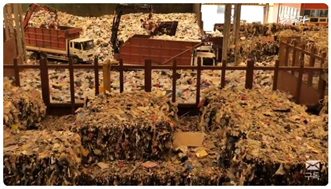
[ Screenshots from Anthropocene ] (Source: Newstapa’s YouTube Channel)
The narration explains that non-recyclable waste is sent to incineration plants or landfills. Yet, the current metropolitan landfill located in Incheon, in use since the 1990s, is now nearing full capacity. While the Ministry of Environment has announced a ban on direct landfilling of waste starting in 2026, disagreements remain between the Ministry, Seoul City, and Incheon City regarding alternative landfill sites.
Waste that doesn’t make it to landfills or incineration plants often flows into river estuaries and the ocean. In fishing villages, shrimp nets pulled from the water bring up heaps of trash mixed with shrimp. Fishermen must painstakingly separate the shrimp from the waste, often using electric fans to blow the debris away. Among the trash retrieved from the sea, items like plastic wrappers for products discontinued more than 20 years ago are found completely intact, a haunting reminder of waste’s persistence. The film concludes with the chilling statement that dealing with marine waste has also fallen to the elderly fishermen left behind in these rural fishing communities.
During the talk concert session following the screening, the director revealed that the idea for the film was sparked by the shock he felt while visiting a recycling facility. He expressed deep emotional distress at seeing the overwhelming amount of waste being manually processed, particularly by society’s most vulnerable members. He explained that older cardboard collectors, in particular, are not recognized as formal workers and are excluded from basic protections such as national insurance or minimum wage coverage. This marginalization inspired him to focus on their plight and feature their stories prominently at the beginning of the film.
The screening was followed by the official opening speeches of LOVERE:PAPER (hereafter, LRP), the event host, and Beautiful Store, a nonprofit organization and charity shop that served as the event’s sponsor. The first session of the conference featured a presentation by Mr. Bae Jaeyoon, associate research fellow of Korea Labor Force Development Institute for the Aged (KORDI). He introduced the findings of the 2023 Survey on the Current Conditions of Older Waste Collectors and National Policy Directions (the Survey hereafter), a project conducted in collaboration with the Ministry of Health and Welfare. Mr. Bae previously partnered with Korea Broadcasting System (KBS) on a joint project that highlighted the challenges faced by older waste pickers, culminating in a documentary titled GPS and Handcarts: The State of Recyclable Paper Collection. During his session, he provided an in-depth overview of the survey methods and policy recommendations derived from the study.
The purpose of the Survey was to estimate the total number of older waste collectors in South Korea and to examine their working conditions and welfare needs. With no prior nationwide studies conducted on this population, even the exact number of active collectors remained unclear. To address this gap, Mr. Bae designed the Survey by first identifying the locations of scrap dealers across the country and then tallying the number of older collectors who traded with them.
However, neither the Ministry of Environment nor local governments had precise data on this issue, posing an additional challenge. To overcome this limitation, the research team filed administrative information disclosure requests with municipal and district offices across South Korea while simultaneously conducting direct investigations. Through this effort, they compiled a list of 7,984 scrap dealers from 226 local governments; the estimated number of older waste collectors nationwide based on this data was 41,876.
From this population, a sample of 105 scrap dealers and 1,035 older collectors was selected for interviews. The interviews gathered information on their average monthly income, delivery volume, health conditions, experience with senior job programs, and personal and household characteristics.
The survey results revealed that approximately 65% of the respondents had either no formal education or had only completed elementary school. Most reported poor health conditions and worked alone, though those who had companions were usually accompanied by their spouses. Economic hardship was identified as the primary reason for engaging in waste collection.
He added that the research team conducted a comparative analysis of working hours and yields during extreme heat, extreme cold, and other seasons, as they hypothesized seasonal variations in these metrics. Contrary to their expectations, the results showed no significant differences, indicating that the subjects continued working almost six days per week regardless of weather conditions, except on days when scrap dealers were closed.
Despite their hard labor, the average monthly earnings amounted to approximately KRW 150,000 or USD 104.50. However, Mr. Bae noted that the Survey included individuals who engaged in waste collection for reasons other than livelihood, such as socializing or as a hobby. He suggested that further analysis, factoring in the participants’ assets, might yield different insights.
The survey report outlined three major policy recommendations: establishing a management system through a comprehensive nationwide survey; linking support initiatives for older waste pickers and senior job programs as well as other relevant cross-sectoral support activities; and connecting tailored health and welfare services. These recommendations have been adopted by the government and are in the process of implementation as of 2024.
Mr. Bae concluded his session by noting that formal support measures for older waste pickers are still in their early stages. He emphasized the need to carefully monitor their impact by actively listening to voices from the field and highlighted the importance of follow-up research to ensure their effectiveness.
Following Mr. Bae’s presentation, Mr. Ki Woo-jin, CEO of LRP, took the floor to challenge society’s perception of waste collectors as mere elderly welfare recipients. He advocated for a shift toward the emerging global perspective that recognizes them as respectable economic contributors earning their livelihoods.
The term waste pickers was officially designated at the First World Conference of Waste Pickers, held in Bogotá, Colombia, in 2008, to refer to individuals who collect discarded materials of various sorts. The Global Alliance of Waste Pickers, an international organization representing this community, estimates that there are approximately 460,000 waste pickers across 34 countries worldwide. Internationally, waste pickers are recognized as formal workers in the recycling industry, acknowledged for their significant environmental contributions, including reducing CO2 emissions and marine waste.
To illustrate these positive global perspectives, Mr. Ki referenced a 2.5-minute speech delivered by Soledad Mella, President of the Global Alliance of Waste Pickers, at the 2022 UN Environment Assembly. In her speech, Mella highlighted the vision of waste pickers and their role in advancing the Global Plastics Treaty.
Mr. Ki, in turn, emphasized the importance of changing perceptions around waste collection labor. To promote a more appreciative and contributive view of the work, LRP coined the term Resource Recovery Practitioner in 2019 as a replacement for older cardboard collectors. This term was also chosen through a public idea contest organized by the National Institute of Ecology to rename recycling workers.
Mr. Ki further highlighted the economic value of waste paper collection, noting that 56,358 tons of cardboard are collected annually, which is estimated to reduce 28,179 tons of CO2 emissions each year. He added that applying carbon credits to this reduction would yield an economic value of approximately KRW 2.8 billion (USD 1.94 million).
Concluding his presentation, Mr. Ki underscored the importance of recognizing the social contributions of older waste pickers and called for policy support that reflects the significance of their efforts.
The third session featured a panel discussion with participants from earlier sessions, including Director Lim, Mr. Bae, and Mr. Ki, alongside Shim Hyun-bo, CEO of the social enterprise Arip & Werip (我立 and we立), and Ko Hyun-jong, Secretary General of Senior Union, an organization for workers over 55. The panelists explored various perspectives on addressing the challenges faced by older waste pickers, focusing on the differing implications of the terms older waste pickers and resource recovery practitioners.
Mr. Ko critiqued the government’s recent support policies for older waste collectors, noting that while establishing a nationwide estimate of their population through the survey was meaningful, it is problematic to forcibly transition waste collection work into senior job programs without considering the individuals’ choices. He also expressed concern that the term resource recovery practitioner might fail to accurately reflect the harsh realities of elderly poverty, emphasizing that this issue must be approached from a broader perspective of senior welfare, particularly through measures like pensions.
In response, Mr. Shim stressed the importance of creating safe and sustainable job opportunities for older adults as alternatives to waste collection. He argued that well-structured support for specific groups could generate positive ripple effects. As an example, he highlighted the business model of New Year Market, which sells products featuring artwork created in collaboration with older waste collectors. By compensating them for their creative contributions, the model not only provides new roles as creators but also generates additional employment opportunities in packaging and distribution.
Mr. Ki clarified that supporting older waste pickers or adopting the term resource recovery practitioners does not imply endorsing waste collection as desirable work. Rather, he explained, these efforts are short-term measures aimed at addressing the issue of older waste collectors, one of the most visible manifestations of elderly poverty today. Reflecting on his 11 years of working with older waste pickers, many of whom have since passed away, Mr. Ki noted that LRP has chosen solutions designed to provide these individuals with tangible improvements in their remaining years.
The fourth session explored support initiatives for resource recovery practitioners by various organizations, including Beautiful Store, LRP, the Silver Resource Cooperative, and the Regeneration and Healing team from the Seoul National University Student Social Responsibility initiative.
Beautiful Store presented its Beautiful Sharing Bundle project, which provides tailored supplies such as safety gear and functional t-shirts to older waste collectors in need across Seoul, Gyeonggi, and Incheon areas. The project demonstrated thoughtful planning, with annual adjustments to the selection and details of the supplies to ensure effective support.
[ Supplies from Beautiful Sharing Bundle project in display ]
Following this, LRP shared the achievements of its 2023 campaign, "We Are Resource Recovery Practitioners", aimed at transforming public perceptions of older cardboard collectors. The campaign sought to inspire a fresh perspective on the work of waste pickers by encouraging participants to take part in waste collection activities themselves.
One notable activity involved attaching supportive message stickers to the carts of waste collectors, empowering them to take pride in their contributions. Over 300 participants shared photos and reflections of their experiences on social media, revealing a newfound awareness of the resource-recycling value of waste collection and the pressing need to support older collectors.
Next, the Silver Resource Cooperative, which has been actively supporting older waste collectors in Incheon, presented its achievements, including participation in senior job market projects. The cooperative also proposed several policy recommendations, such as adopting standardized senior job models for waste collection nationwide and establishing safe and efficient waste collection systems at the community level.
Building on this, the Regeneration and Healing team from the Seoul National University Student Social Responsibility initiative introduced an emotional support program for older waste collectors through art-based activities. Over eight sessions spanning three months, the team facilitated art therapy programs such as poetry illustration and personalized calendar-making. These efforts were further enhanced by related activities, including booth exhibitions, magazine publications, and an art exhibition. Although the team has since disbanded, their social enterprise partner, Kkullim, has expanded the initiative by launching a long-term cultural support program, which provides two annual outings for older waste collectors.
The event also featured the debut of the LOVERE:CAR, an electric handcart independently developed by LRP to reduce the physical burden on older waste pickers. This automatic handcart not only adjusts its speed to match the user’s stride but is also compact, with dimensions under one meter in width. According to traffic regulations, handcarts exceeding one meter in width are classified as vehicles and must be used on roadways, but this cart’s slim design allows it to be safely used on sidewalks.
The cart features USB ports for charging portable devices like handheld fans or playing music on the go. Additionally, it is equipped with an umbrella holder, safety lights, and a backup alarm to enhance user safety. Its thoughtful design, tailored to the real needs of users, demonstrates the level of consideration and commitment LRP invested in developing a solution to ease the daily burdens faced by waste collectors.
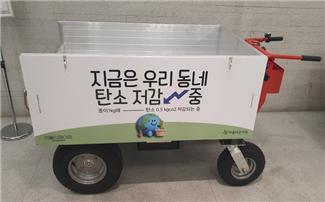
[ (Left) LOVERE:CAR, the electric handcart developed by LRP in exhibition
(Right) Mr. Ki demonstrating LOVERE:CAR during his presentation ]
With Mr. Ki Woo-jin’s closing remarks, the second Resource Recovery Practitioners’ Conference came to a successful close. Despite focusing on the single issue of challenges faced by older waste collectors, the event brought together participants from diverse backgrounds. Notably, some attendees traveled from distant cities such as Busan and Ulsan to join the discussion and share their perspectives. Carrying with them the insights and stories exchanged during the conference, these participants are undoubtedly continuing their efforts to address the pressing issues facing older waste collectors in their respective fields. We eagerly anticipate the third Resource Recovery Practitioners’ Conference, where even more innovative ideas and impactful conversations await.
